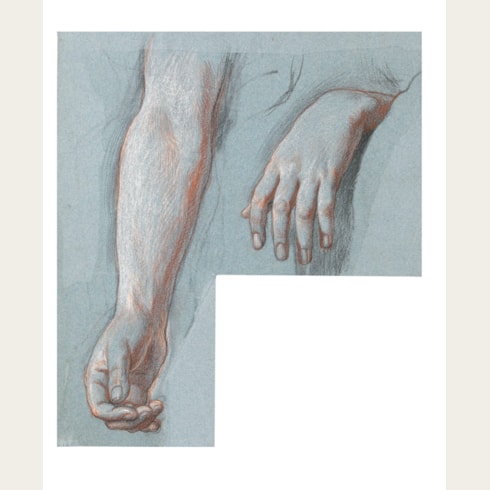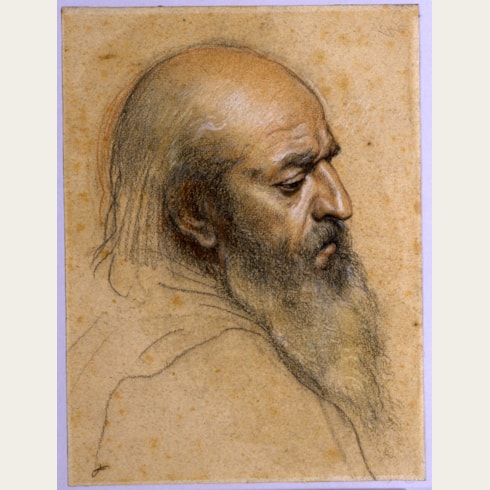Alexandre HESSE
(Paris 1806 - Paris 1879)
The Head of a Man Looking Down
Sold
Black and red chalk, with touches of white heightening, on blue paper.
130 x 100 mm. (5 1/8 x 3 7/8 in.) at greatest dimensions.
130 x 100 mm. (5 1/8 x 3 7/8 in.) at greatest dimensions.
This is a study for the head of a monk at the lower left corner of Alexandre Hesse’s mural of Le Miracle des Ardents (The Miracle of the Burning) in the chapel of Sainte-Geneviève in the church of Saint-Séverin in Paris. The first of Hesse’s major church commissions, begun in 1850 when he was forty-four years old, the decoration of the chapel with four scenes from the life of Saint Geneviève was completed in 1852. (The paintings in the chapel, which were quite dirty and had some water damage, have recently been restored.) The painting of Le Miracle des Ardents, on the upper register of the right-hand wall of the chapel, takes as its subject an episode in the medieval history of Paris. In 1129 an epidemic of a severe, burning fever – the mal des ardents (‘fire sickness’), also known as ‘St. Anthony’s fire’, which doctors were unable to treat and was often fatal – struck the population of the city. The Bishop of Paris and the Abbot of Sainte-Geneviève carried a reliquary with the mortal remains of Saint Geneviève, the patron saint of Paris, in procession throughout the streets of the city, and whoever touched the reliquary were miraculously cured. The following year Pope Innocent II recognized the event as a miracle and established a feast day on the 26th of November each year to commemorate the event.
The present sheet was probably cut from a larger sheet that contained separate studies for the heads and bodies of different figures in a painting. Five preparatory studies for various figures in Le Miracle des Ardents are among the large group of around five hundred drawings by Hesse left at his death to the Ecole des Beaux-Arts in Paris. Two further studies for figures in the same mural painting were exhibited alongside the present sheet in 1979.
The present sheet was probably cut from a larger sheet that contained separate studies for the heads and bodies of different figures in a painting. Five preparatory studies for various figures in Le Miracle des Ardents are among the large group of around five hundred drawings by Hesse left at his death to the Ecole des Beaux-Arts in Paris. Two further studies for figures in the same mural painting were exhibited alongside the present sheet in 1979.
The son and nephew of artists, Alexandre Hesse entered the Ecole des Beaux-Arts in 1821. In 1830 he made his first visit to Italy, and his experiences in Venice inspired his painting of The Funeral of Titian, exhibited at his Salon debut in 1833, where it won a first-class medal. He returned to Italy in the same year, again visiting Venice, where he made several copies after the work of Titian, Tintoretto and Veronese; artists who were to be a particular influence on his own work. In 1836 he received a State commission for a painting of The Body of Henry V Brought Back to the Louvre after his Assassination, intended for the Galerie d’Apollon of the Louvre and today at Versailles, as are two further paintings from French history, commissioned for the Salle des Croisades.
Hesse lived and worked in Rome between 1842 and 1847, and on his return devoted much of his later career to providing paintings for chapels in Parisian churches, including Saint-Séverin, Saint-Sulpice and Saint-Gervais. He also worked at provincial churches and decorated the ceiling of the Palais de la Bourse in Lyon between 1868 and 1870. Hesse continued to exhibit at the Salons until 1861, and in 1867 was nominated to succeed Ingres at to the Institut de France. His last significant commission, for the decoration of a chapel in the Parisian church of Saint-Germain-des-Pres, was left unfinished at his death.
Provenance
The studio of the artist, Paris
Galerie Pierre Gaubert, Paris, in 1979 (with the gallery’s Hesse studio stamp [Lugt 5768] on the verso)
Arnold Klein Gallery, Royal Oak, Michigan
Frederick J. Cummings, Detroit and New York
Eric G. Carlson, New York.
Galerie Pierre Gaubert, Paris, in 1979 (with the gallery’s Hesse studio stamp [Lugt 5768] on the verso)
Arnold Klein Gallery, Royal Oak, Michigan
Frederick J. Cummings, Detroit and New York
Eric G. Carlson, New York.
Literature
Marie-Madeleine Aubrun, Alexandre Hesse 1806-1879: Quelques aspects du portraitiste et du dessinateur, exhibition catalogue, Paris, 1979, unpaginated, no.IV.9.
Exhibition
Paris, Galerie Pierre Gaubert, Alexandre Hesse 1806-1879: Quelques aspects du portraitiste et du dessinateur, April-May 1979, no.9.









